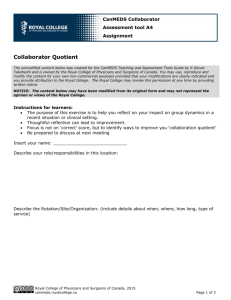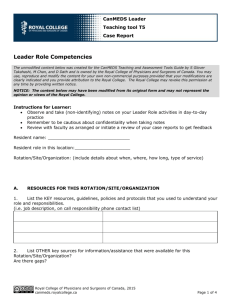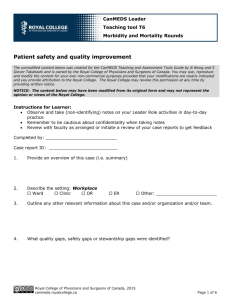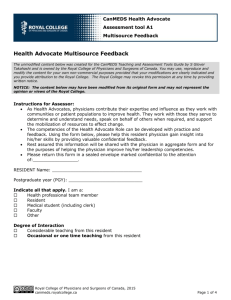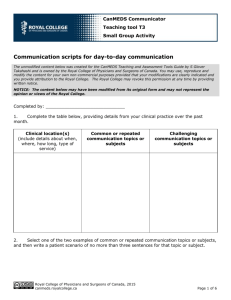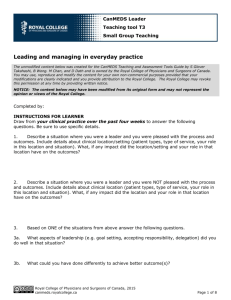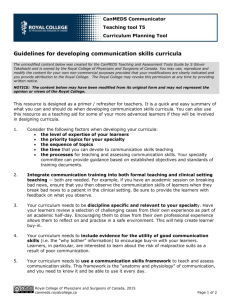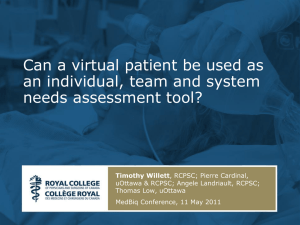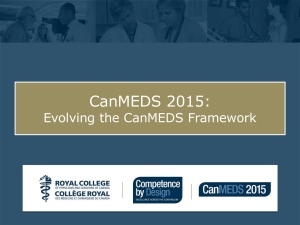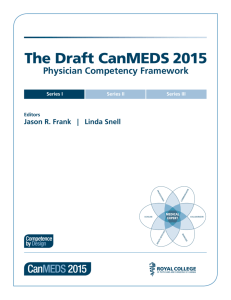MS Word - CanMEDS Interactive
advertisement
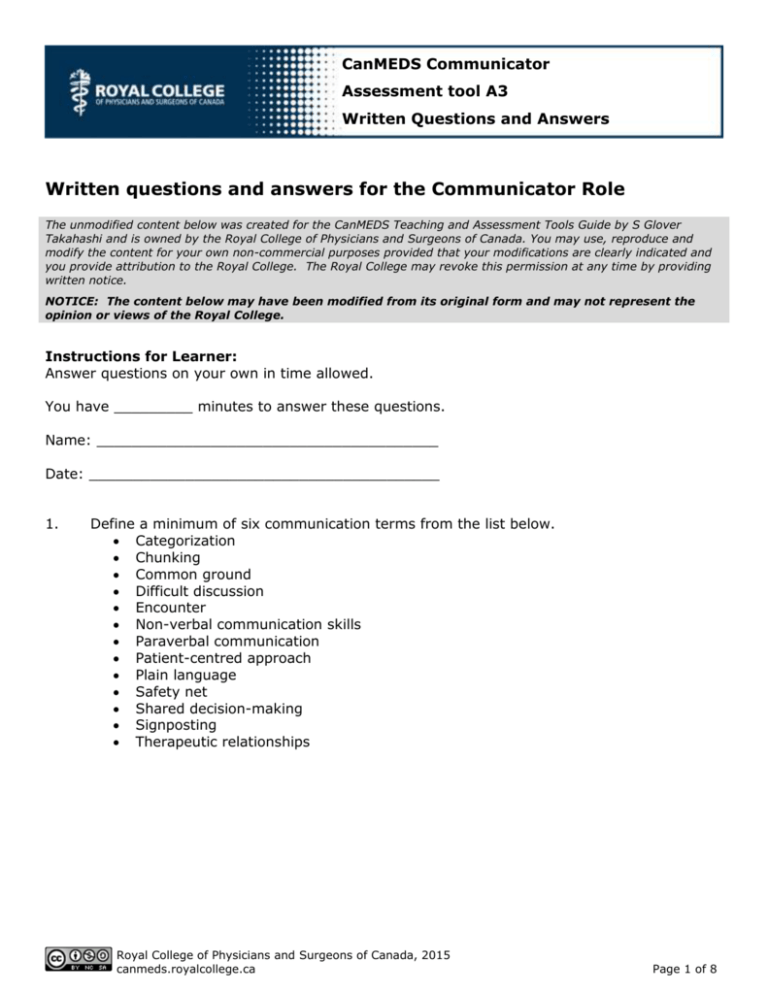
CanMEDS Communicator Assessment tool A3 Written Questions and Answers Written questions and answers for the Communicator Role The unmodified content below was created for the CanMEDS Teaching and Assessment Tools Guide by S Glover Takahashi and is owned by the Royal College of Physicians and Surgeons of Canada. You may use, reproduce and modify the content for your own non-commercial purposes provided that your modifications are clearly indicated and you provide attribution to the Royal College. The Royal College may revoke this permission at any time by providing written notice. NOTICE: The content below may have been modified from its original form and may not represent the opinion or views of the Royal College. Instructions for Learner: Answer questions on your own in time allowed. You have _________ minutes to answer these questions. Name: _______________________________________ Date: ________________________________________ 1. Define a minimum of six communication terms from the list below. Categorization Chunking Common ground Difficult discussion Encounter Non-verbal communication skills Paraverbal communication Patient-centred approach Plain language Safety net Shared decision-making Signposting Therapeutic relationships Royal College of Physicians and Surgeons of Canada, 2015 canmeds.royalcollege.ca Page 1 of 8 CanMEDS Teaching and Assessment Tools Guide Communicator assessment tool A3 2. Complete the table below about verbal communication tasks. Identify the sequence, timing, and purposes of each of the communication skills tasks. Note: one task has been prefilled as an example. No . Verbal communication skills task When it takes place in encounter Purpose(s) (Identify a minimum of two per task) Building the relationship Ongoing Developing a therapeutic alliance Involving the patient 1. 2. 3. 4. 5. 6. Royal College of Physicians and Surgeons of Canada, 2015 canmeds.royalcollege.ca Page 2 of 8 CanMEDS Teaching and Assessment Tools Guide Communicator assessment tool A3 3. Complete the table below by listing some of the details you would include under each of these three parts of a written communication. No. Written communication skills task 1. History 2. Physician Exam Report (e.g. physical exam, interventions, plan, results) 3. Impression and Management Types of details to include 4. Describe the purpose of a consult letter. List three or four things you would cover in the letter (content). List three style/structure elements that you would incorporate into your letter. 5. Identify three impacts and/or outcomes of effective communication. Royal College of Physicians and Surgeons of Canada, 2015 canmeds.royalcollege.ca Page 3 of 8 CanMEDS Teaching and Assessment Tools Guide Communicator assessment tool A3 A3. ANSWER KEY SHORT ANSWER QUESTIONS 1. Define six of these Communicator termsa Categorization is a type of signposting that orients the patient to specific details about how information is going to be discussed. For example, “There are three important things I want to explain. First, I want to tell you what I think is going on; second, what tests I think would be …” Chunking and checking is an approach to giving the patient information in “pieces” then pausing to verify they understand before proceeding. It is a technique used to gauge how much information to give to a patient. This approach aids in achieving a shared understanding with the patient. Common ground provides a basis of mutual interest or agreement Difficult discussion refers to a patient-physician conversation related to the patient’s health care preferences, needs, and values that can be challenging because of the high or intense emotion involved. The topics considered challenging or difficult vary on the basis of the patient’s preferences, needs, and values; the physician’s preferences, needs, values, and comfort level; and the environmental, cultural, and health care contexts. Empathy is a key skill in developing the physician-patient relationship. It has two parts: the understanding and sensitive appreciation of another’s predicament or feeling; and the communication of that understanding back to the patient in a supportive way. It does not necessarily equate to agreeing with the patient’s feelings. An example is “I can see that your husband’s memory loss has been very difficult for you to cope with.” Empathy is often confused with sympathy, which is feeling pity or concern from outside of the patient’s perspective. Encounter refers to a purposeful patient-physician interaction. Non-verbal communication skills are the skills involved in transmitting information without the use of words. They include body language (e.g. facial expressions, eye contact, gestures), paraverbal skills (e.g. tone, pace, volume of speech), touch, space, smell, and clothing. Non-verbal communication is responsible for conveying most of our attitudes, emotions, and affect. Non-verbal communication can override what we actually say to patients. Paraverbal communication is what you convey in the characteristics of your words through your pace, tone, pitch, rhythm, volume, articulation, and use of pauses. Patient-centred approach is one providing care that is respectful of and responsive to individual patient preferences, needs, and values, and ensuring that patient values guide all clinical decisions. Plain language is the use of common words that are understandable by the patient. This may mean avoiding technical or medical terms unless they are carefully defined or described. Royal College of Physicians and Surgeons of Canada, 2015 canmeds.royalcollege.ca Page 4 of 8 CanMEDS Teaching and Assessment Tools Guide Communicator assessment tool A3 Safety net means the set of contingency plans for the patient, which should be discussed at the end of the interview. Providing a safety net for the patient involves explaining what the patient should do if things do not go according to plan, telling them how they should contact you, and discussing what developments might require back-up. Shared decision-making is a communication approach where patients and their health care professionals, including their physician, make decisions following careful deliberation about the patient’s preferences, needs, and values and with an understanding of the available options and evidence so that they can wisely choose the best action(s). Signposting is the use of bridging statements to alert patients that you are changing topics or direction in the encounter. Signposts help the patient to understand where the interview is going and why. They also help to provide structure to the interview and act as guide markers to keep you organized and patient focused. For example, “I have just finished getting a history of your stomach pain; now I would like to do a physical exam. Is that okay?” Therapeutic relationship is the working alliance between the physician and patient. Respect (i.e. unconditional positive regard), genuineness, and empathy have been correlated with good therapeutic outcomes. 2. Complete the table below about verbal communication task. Identify the sequence, timing, and purposes of each of the communication tasks.bc # Verbal Communication COMMUNICATION TASK Timing PURPOSES (2-4 per task) 1. INITIATING THE SESSION Beginning Establishing initial rapport Identifying the reason for the visit 2. GATHERING INFO AND PHYSICAL EXAM Middle Exploration of the patient problem to discover: Biomedical perspective (disease) Patient perspective (illness) Background information – context 3. EXPLANATION AND PLANNING Middle Providing the correct type and level of information Aiding accurate recall and understanding Achieving a shared understanding – incorporating the patient’s perspective Planning – shared decision-making 4. CLOSING THE SESSION End Ensuring appropriate point of closure Forward planning 5. BUILDING THE RELATIONSHIP Ongoing Developing a therapeutic alliance Involving the patient 6. PROVIDING STRUCTURE Ongoing Making organization overt Royal College of Physicians and Surgeons of Canada, 2015 canmeds.royalcollege.ca Page 5 of 8 CanMEDS Teaching and Assessment Tools Guide Communicator assessment tool A3 Attending to flow 3. Complete the table below by listing some of the details you would include under each of these three parts of a written communication. CONTENT Sample details 1. History Chief problem/reason for referral Chief complaint Relevant past history Current medications, as appropriate Other history appropriate to presenting problem: psychosocial history, functional history, family history, review of systems, etc. 2. Physical Exam Physical examination findings relevant to presenting problem 3. Impression and Management Diagnosis and/or differential diagnosis Management plan Rationale for the management plan (education) Report on whether the management plan was discussed with patient Notes who will be responsible for elements of the management plan and follow-up Answer the referring physicians question (if present) 4. Describe the purpose of a consult letter. List three or four things you would cover in the letter (content). List three style/structure elements that you would incorporate into your letter. Written Communicati PURPOSE CONTENT on CONSULT LETTER Communic ates findings and opinions to the referring physician Referring physicians want: the consultants impressions (dx and answer to the referring question) management plan (who will do what and when medication changes rationale for recommendations who is providing ongoing care guidance and education Royal College of Physicians and Surgeons of Canada, 2015 canmeds.royalcollege.ca STYLE Language Simple language No abbreviations, acronyms Short words (less than three syllables) Active vs. passive voice (“I saw Ms. X …” vs. “Ms. X was seen …” Visual display Organized Bullet points Short sentences (one idea per sentence) Short paragraphs (four to five Page 6 of 8 CanMEDS Teaching and Assessment Tools Guide (articles, advice, guidelines) Consultants want: Record of the history and physical exam Context that enables the interpretation of investigations Proof the consultation actually occurred A clear question 5. Communicator assessment tool A3 sentences) Section headings Graphics Right amount of information Edited (Plan, Dictate, Edit) Identify three impacts/outcomes of effective communications. # Impacts/outcomes of effective communications. 1. Increased accuracy, which improves patient understanding, recall, and compliance and increases efficiency for patients and physicians, 2. Improved outcomes of care (physiological and psychological), 3. Heightened perceptions by patients that they are supported by their physicians and improved relationships between patients and caregivers, resulting in higher satisfaction for patients and physicians, 4. Reduced rates of adverse events/medical errors, and 5. Better protection against complaints and malpractice claims. Royal College of Physicians and Surgeons of Canada, 2015 canmeds.royalcollege.ca Page 7 of 8 CanMEDS Teaching and Assessment Tools Guide Communicator assessment tool A3 Refer to Communicator Key Terms in the tool Guide for full definitions. b Kurtz SM, Silverman JD. The Calgary-Cambridge Referenced Observation Guides: an aid to defining the curriculum and organizing the teaching in communication training programmes. Med Educ. 1996 Mar; 30(2):83-9. c Silverman J, Kurtz S, Draper J. Skills for communicating with patients. 3rd ed. London: Radcliffe Publishing. Copyright © 2013. Reproduced by permission of Taylor & Francis Books UK. a Royal College of Physicians and Surgeons of Canada, 2015 canmeds.royalcollege.ca Page 8 of 8
